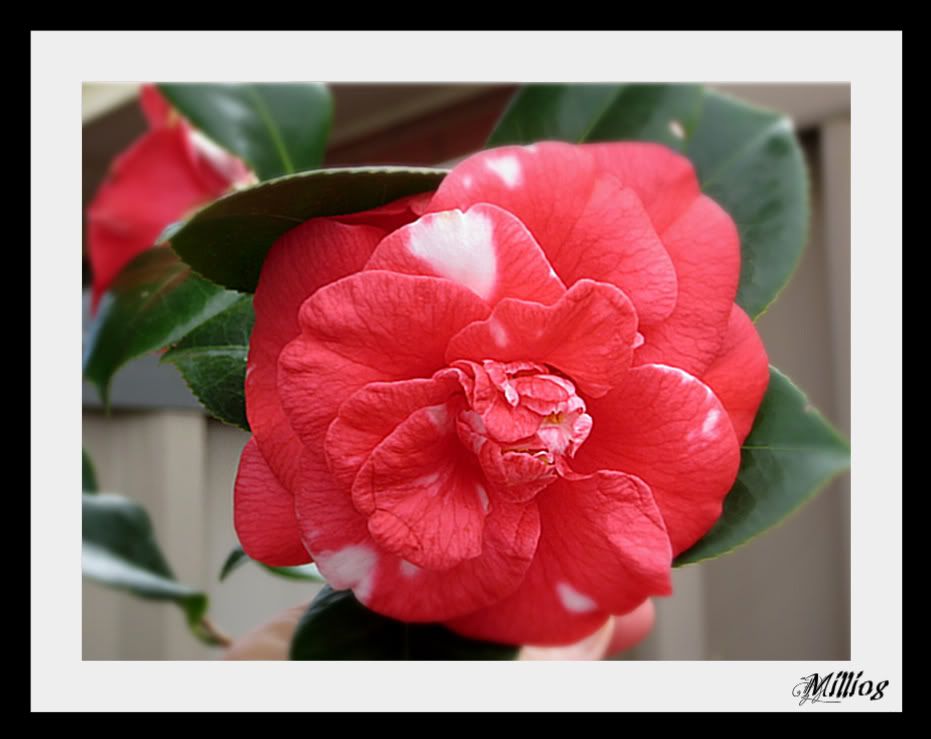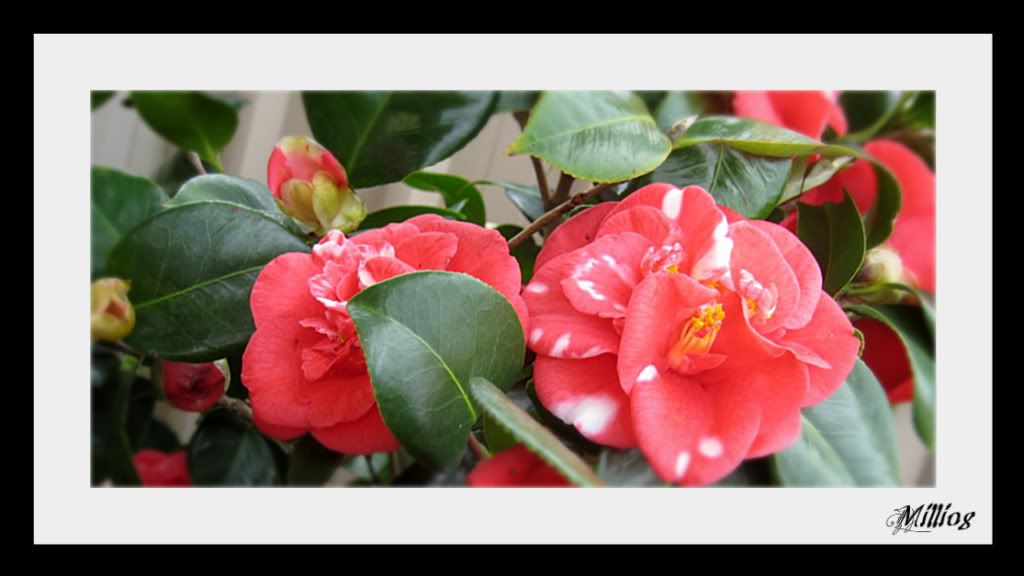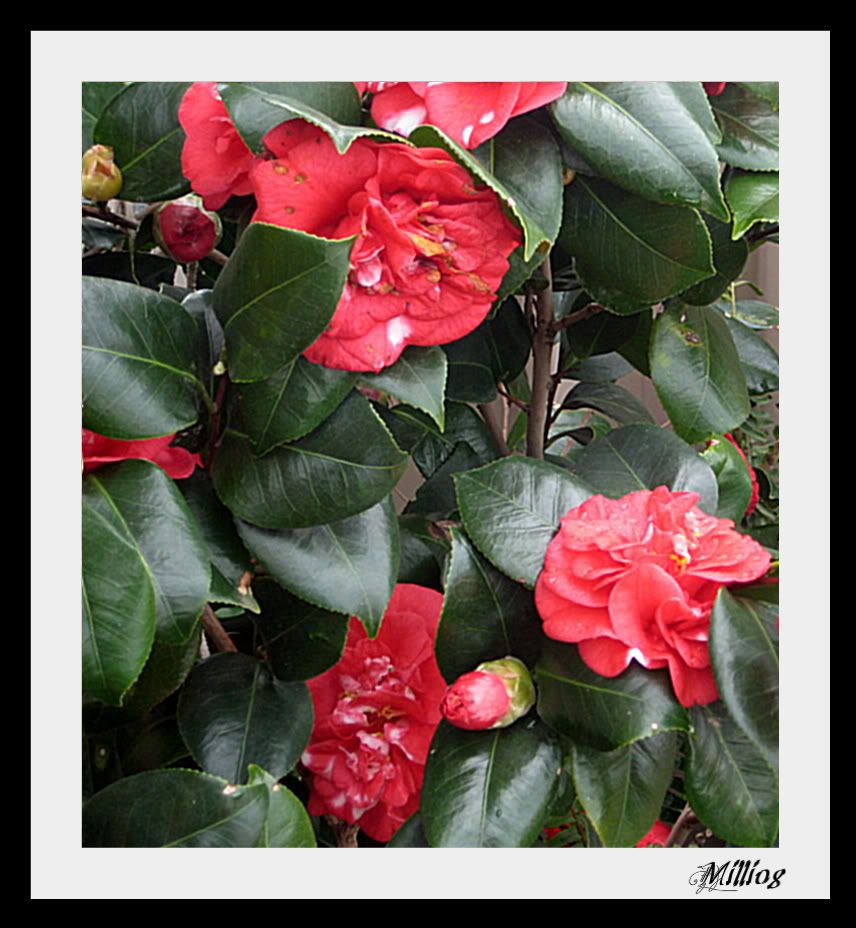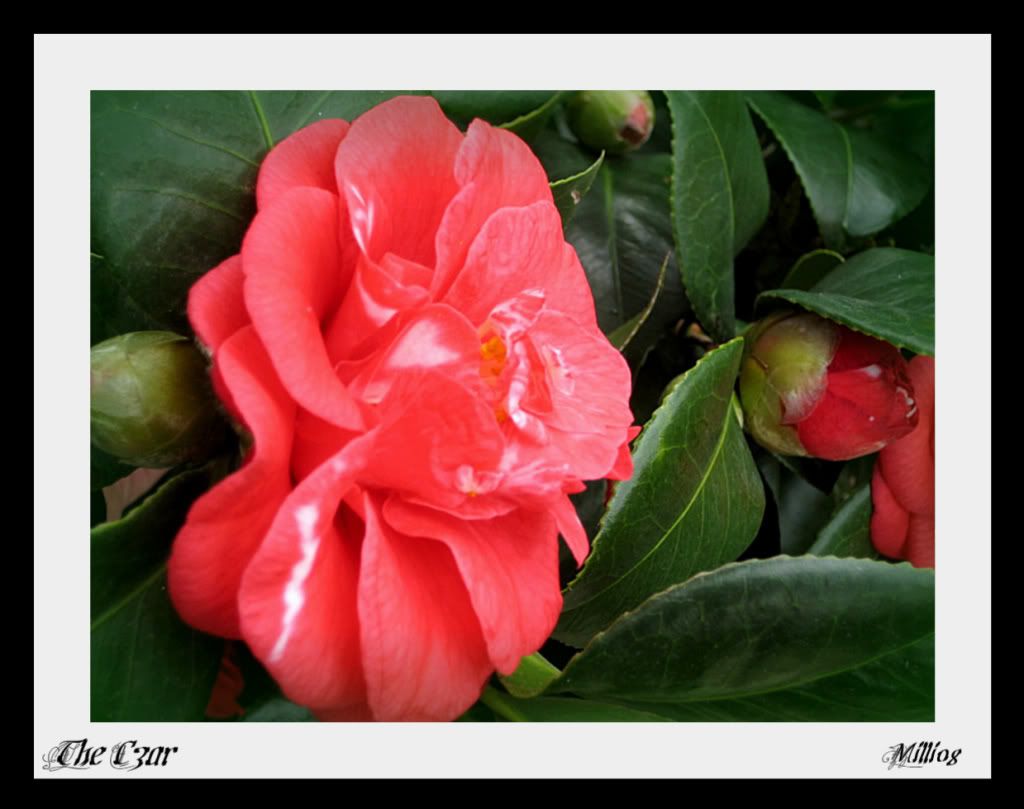
It was officially the first day of spring here yesterday and even though the afternoon was a wet one and thankfully gave us more rain, today is a beautiful Spring day. Birds chirping under a blue sky and just a slight breeze. In the garden buds are appearing aplenty.

I was visiting my mother and noticed her camellia was very much in flower a few weeks back , and so as I do I reached for my little camera and took a few photos of the camellia as we chatted.
Mum has this beautiful 35 year old Camellia Japonica planted in an old washing machine drum and growing oh so well, for the upheavals of relocating to a few different locations over this thirty five year period. From hills to seaside it has successfully traversed in the big old tub and the fact that it is in a tub where maybe it is by now root bound has probably been it's saviour. Not that you would know that it has lived in different places because as you can see by the photos here it still looks pretty good.
I love Camellias and this one called The Czar is quite striking with its dark green leaves and these big double flowers in a gorgeous crimson pink with streaks of white appearing over some of the petals.

A little bit about the Camellia taken from the net:
The earliest recorded information of camellias coming to Australia is towards the end of 1786 when preparations were under way for fitting out the fleet that was to convey the first convicts to Australia. In Sir Joseph Banks list of plants and seeds to be transported to Australia were two tea plants. These were sent on the ship Sirius and came under Governor Phillips direct supervision. No account of the safe arrival of the tea plants or their subsequent cultivation in Sydney has so far been found.
In 1789 two more tea plants were sent aboard the ship Guardian but on Christmas eve the Guardian was lost at sea. When this news reached Britain the Gorgon was fitted out as a replacement. While lists of the plants and seeds sent on the Gorgon have not been traced, it has been assumed that they were the same list to those sent on the Guardian. Phillip Gidley King who returned to Australia on the Gorgon ship, wrote from Sydney in October 1791 that the fruit trees and other plants were all ina very good state on our arrival in Sydney.
While we do not know how successful these efforts by Banks to introduce C. sinensis were, we do know that it had been successfully established by 1796. in that year William Paterson, the soldier botanist friend of Banks who had lived in N.S.W. since 1791, returned to England. William discussed with Banks the plant requirements of the colony and Banks annotated his Guardian list, noting all the plants marked with a pencil tick,Col Paterson tells me are growing in the colony. Tea was one of the plants Banks ticked. So the first recorded camellias to be brought to Australia were C. sinensis in 1791. In 1798 two more tea plants were sent on the ship Porpoise under the care of George Sutter. Sutter bought 18 boxes containing plants. Box 14 contained 2 tea plants, 1 Averhoe, 3 Brucca and 1 Jalope plant.
George Sutter was given a land grant of 186 acres at Baulkam Hills which he names Chelsea Farm. George established the first orchard and nursery in Australia and in a few years was supplying Sydney with fruit particularly oranges and lemons. In 1843 George Sutter published a small book on grapes and oranges, and died May 5 1859.
Though these Camellia sinensis plants survived and lived for a while all of them eventually died.
The oldest tea plant growing in the Botanic Gardens Sydney was planted in 1828 and had been introduced from China in 1823 by John Reeves.
Charies Fraser reaches Sydney in 1816 as a Private in the 56th Regiment. Governor Macquarie placed him in charge of the garden of the government. that was to develop into the Sydney Botanic Gardens and in 1821 appointed him Colonial Botanist.
The following manuscript, Catalogue of Plants Cultivated in the Botanic Gardens Sydney was prepared by Charles Fraser, dated by him January 1828.
Link here to read more from this site
History of Camellias in Australia by John Fowler.
The Camellia surely is a beautiful flower although it does not do as well as a cut flower. It is best to sit the flower itself in a float bowl for the prettiest of results.
I hope that you have enjoyed The Czar and here is a last photo before the flowers yellow off and drop to the ground therein making a very pretty carpet across the earthen floor.

Milli 2008
What a gorgeous plant - I can hardly believe they spent the last 35 years in a washing machine tub! WOW! They growing and surviving quite well! Is the camellia a relation to the tea plant? If so, I had no idea!. I've always loved camellias and azalea - rhododendrons too. (Unfortunately they are posionous to dogs, along with a whole list of plants - all of them I absolutely love!) I was quite impressed with the history of the plant being introduced to Australia. What are some of Australia's native plants?
ReplyDeleteThese are beautiful photographs too! Thanks so much! :-)
Hi there Marcia they are related to the tea plant. I will dig some more info for you or even click at the top of this page where it is highlighted in Blue 'The Czar'. That is a wiki link to the plant. Ok wee have some stunning natives and I will promise you a post and some pictures of them soon. The old washing machine drum must have been just the right thing along with mums duty and care..Ahh some Mum's know how to do this don't they?
ReplyDeleteMy mother was another one who could keep almost anything alive! Their front yard was just gorgeous. My dad took immaculate care of the lawn and my mother took care of the border plants and all the other things in the landscape. People would actually drive down the street and stop to look at their yard. I have never had such luck. When we moved in this house it had a beautiful Japanese Maple in the front garden. It was taller than the house. Unfortunately, year by year parts of it would die until finely there was only one section that remained alive. We chopped it down last year and are trying to figure out what will take it's place. We have a lace leaf, weeping Japanese Maple in a huge pot on the back deck; however, last winter the pot cracked and broke open in about 5 places. It's now being held together with duct tape [ugly] and we have plans to plant it out front. I'm terrified to transplant it as I'm afraid it will die this coming winter. It gets pretty windy here and they're not keen on heavy winds. Where it was it was semi-protected. On well, if it dies, hopefully I'll have learned something. :-)
ReplyDeleteBeautiful photos Milli
ReplyDeleteA striking color, full, glourious and no less a Czar. Camellias have their own sense of regalness and beauty that can draw the eye. These were great shot. Thanks, Milli ... Huggers 8=)
ReplyDeleteNice mix of colour and composition and an interesting story.
ReplyDeleteHave never visited but did try to emigrate twice.
No good going anywhere unless everyone agrees.
this is such a wonderful blog. Photos fantastic but love the history and the sharing of something intimate within your family - truly made it more wonderful to read. Camellias are my favourite flower - mainly because of as a child there was one on the way home from my aunties and I would collect some and take em home and the love has stayed with me since - so even nicer to read with these thoughts too. Thanks Milli!
ReplyDeleteCamellias and Magnolias, love those. Neat Blog Milli, liked it very much.
ReplyDeleteThanks for the visits today and now I have added a few more photos taken today into a slide show. A first this slide show is for me up until now. I will come back tomorrow and reply to everyone here. Enjoy!
ReplyDeleteHei Milli
ReplyDeleteWOW!!
A very befitting name to this very beautiful and noble plant!
All the photos are outstanding. Hugz
these images truly give pleasure to the senses and exalts the mind, milli! great info about the czar, too.
ReplyDelete'love this wonderful post of yours! keep them coming...",)
Very lovely! I really like the white splashes :-)
ReplyDeleteWhat a wonderful story in the comments here Marcia. However the Tree is a bit of a sorry story. I have transferred big trees into the ground however with the tree you are talking about just maybe it loves the position that it is in already. So why not find another big container for it? You will need a pot at least bigger than the pst you have it in already. If you do plant it out you will need a big hole to accommodate the tap root and when you shift it try to keep it as compact and complete as possible. The smaller auxiliary roots are not so much a problem but shift it a the right time of the year or as per your local nursery would advise or a good local tree arborist http://en.wikipedia.org/wiki/Arborist
ReplyDeleteThanks Chezz.
ReplyDeleteYou are so sweet Bill and you have the term regal perfectly coined for a camellia. Thank you Bill the flowers do draw the eye of the beholder.
ReplyDeleteNice comment Bill and you are correct it s no use going anywhere unless everyone agrees. While your walking and talking thinking as sharply as you do, it is never too late for a visit though.
ReplyDeleteKeith what a super story you have shared here. How wonderful that you associate so much love with this beautiful and regal flower. Thank You so Keith!!!
ReplyDeleteThanks Mia and I too love magnolias.
ReplyDeleteGreat to see you Rii ah noble another great word to use for these plants. Thanks Rii for the visit.
ReplyDeletePinky glad that you enjoyed so much and yes I will do more. Keep coming over to read thank you.
ReplyDeleteYes the white splashes make it unique so glad you dropped by Amy.
ReplyDeleteThanks for posting this ... the photos of the Camellia are absolutely delightful. But what intrigued me is that this Camellia is 35 years old !!! May it continue to flourish :)
ReplyDeleteI think I heard once that Camelias actually enjoy being rootbound..I may be wrong,but feel I did hear that.I had also heard they make tea from certain Camelia..yeah they are as tough as ole boots aren't they..I had a couple in my New Zealand garden too,one of my neighbors milli had a huge camlia tree all of 20ft high,been there for years the flowers were a cyclamen colour,and looked an absolute beauty when in full bloom,these are usually found around old houses,where they been forever almost
ReplyDeleteIt was wonderful to see this post again :-)
ReplyDeleteYes Jacquie Chinese Tea comes from Camellia leaves.
ReplyDeleteIn fact it is this one, Camellia sinensis.
I have seen Camellias in the hills as high as you have said and they are absolutely glorious.
I think that camellias were an old fashioned favourite and now have made the come back trail again with many new varieties for the new gardeners.
Wow, what a beautiful specimen. Thanks for posting this. I didn't realize it had the white, i love that. In addition to the history of the camellia in Australia I'd like to add that 'The Czar' shown here is an Australian borne cultivar. What a wonderful contribution.
ReplyDeleteYou are more than welcome Vic and I am so glad that you mentioned this to me.
ReplyDeleteI discovered the lil fact when i looked it up.
ReplyDeleteAlways learning and it is Great Mate!
ReplyDeleteI feel bad for not knowing the name of my cultivar. These were very early purchase before I paid attention to such things. I do know it mine and yours are both camellia japonicas I'm not sure what the other camellia family is. t had a man's name.
ReplyDeleteI believe yours is a semi double. I think mine is a full double, but not sure the petal count for semi and full double is the same for camellias as it is for roses. I would expect it to be similar.
I've only recently developed interest in camellia varieties. What I have is the most common variety i see here, or one very much like it. i think i may like the single and semi doubles better than mine. I"m not sure where I would put another, but I have my eye on one I'll be getting a cutting from to root.
i'm really impressed by the white in this. I don't think i ever saw a multi colored camelia before.
ReplyDeleteThis is an Aussie site below but it will give you insight into the different types of Camellias..if you find what you like then google it for your countries listings.
ReplyDeletehttp://www.camelliasrus.com.au/
thanks, i'll browse thru it. You should consider starting a cutting from your mom's for yourself, just for the family history.
ReplyDeleteI agree Vic and I will..you know the more I see the more I like and the hedging Camelias are stunning and it seems tough too.
ReplyDeleteCamellia Sasanquas
Woohoo that's the other one. whew! Yer a genius.
ReplyDeleteHave you experience rooting cuttings?
I have not done very much except the usual old wood cuttings from the likes of daisies, pelargoniums and the like. However I can give it a go.
ReplyDeleteI've not done camellias but I'm a pro with gardenias, should be a similar technique, I'd guess. For Gardenias I use old wood.
ReplyDeleteOld wood is the best wood for propagating so you are on track.
ReplyDeleteI didn't know you loved camellias, Milli! Stunning photos of such a beautiful flower. I'm very fond of camellias and on the other I visited a camellia exhibition. I had never thought there were so many varieties of this flower. Should you like to give a look at the slide-show I posted pls click http://belita747.multiply.com/journal/item/1781/DO_YOU_LIKE_CAMELLIAS_slide-show
ReplyDeleteHave a nice rest of the week!
Thanks Belita.
ReplyDeleteI am off to have a look at your slide show. Glad that you dropped by.